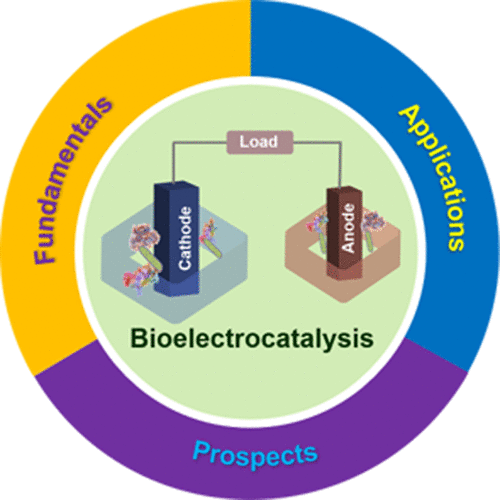当前位置:
X-MOL 学术
›
Chem. Rev.
›
论文详情
Our official English website, www.x-mol.net, welcomes your feedback! (Note: you will need to create a separate account there.)
Fundamentals, Applications, and Future Directions of Bioelectrocatalysis
Chemical Reviews ( IF 51.4 ) Pub Date : 2020-10-14 , DOI: 10.1021/acs.chemrev.0c00472 Hui Chen 1 , Olja Simoska 1 , Koun Lim 1 , Matteo Grattieri 1 , Mengwei Yuan 1 , Fangyuan Dong 1 , Yoo Seok Lee 1 , Kevin Beaver 1 , Samali Weliwatte 1 , Erin M Gaffney 1 , Shelley D Minteer 1
Chemical Reviews ( IF 51.4 ) Pub Date : 2020-10-14 , DOI: 10.1021/acs.chemrev.0c00472 Hui Chen 1 , Olja Simoska 1 , Koun Lim 1 , Matteo Grattieri 1 , Mengwei Yuan 1 , Fangyuan Dong 1 , Yoo Seok Lee 1 , Kevin Beaver 1 , Samali Weliwatte 1 , Erin M Gaffney 1 , Shelley D Minteer 1
Affiliation

|
Bioelectrocatalysis is an interdisciplinary research field combining biocatalysis and electrocatalysis via the utilization of materials derived from biological systems as catalysts to catalyze the redox reactions occurring at an electrode. Bioelectrocatalysis synergistically couples the merits of both biocatalysis and electrocatalysis. The advantages of biocatalysis include high activity, high selectivity, wide substrate scope, and mild reaction conditions. The advantages of electrocatalysis include the possible utilization of renewable electricity as an electron source and high energy conversion efficiency. These properties are integrated to achieve selective biosensing, efficient energy conversion, and the production of diverse products. This review seeks to systematically and comprehensively detail the fundamentals, analyze the existing problems, summarize the development status and applications, and look toward the future development directions of bioelectrocatalysis. First, the structure, function, and modification of bioelectrocatalysts are discussed. Second, the essentials of bioelectrocatalytic systems, including electron transfer mechanisms, electrode materials, and reaction medium, are described. Third, the application of bioelectrocatalysis in the fields of biosensors, fuel cells, solar cells, catalytic mechanism studies, and bioelectrosyntheses of high-value chemicals are systematically summarized. Finally, future developments and a perspective on bioelectrocatalysis are suggested.
中文翻译:

生物电催化的基础、应用和未来方向
生物电催化是一个跨学科的研究领域,通过利用来自生物系统的材料作为催化剂来催化发生在电极上的氧化还原反应,从而将生物催化和电催化相结合。生物电催化协同地结合了生物催化和电催化的优点。生物催化的优点包括高活性、高选择性、底物范围广、反应条件温和。电催化的优点包括可能利用可再生电力作为电子源和高能量转换效率。整合这些特性以实现选择性生物传感、高效能量转换和多样化产品的生产。本次审查旨在系统和全面地详细介绍基本原理,分析存在的问题,总结发展现状和应用,展望未来生物电催化的发展方向。首先,讨论了生物电催化剂的结构、功能和改性。其次,描述了生物电催化系统的基本要素,包括电子转移机制、电极材料和反应介质。第三,系统总结了生物电催化在生物传感器、燃料电池、太阳能电池、催化机理研究、高价值化学品生物电合成等领域的应用。最后,对生物电催化的未来发展和前景提出了建议。并讨论了生物电催化剂的改性。其次,描述了生物电催化系统的基本要素,包括电子转移机制、电极材料和反应介质。第三,系统总结了生物电催化在生物传感器、燃料电池、太阳能电池、催化机理研究、高价值化学品生物电合成等领域的应用。最后,对生物电催化的未来发展和前景提出了建议。并讨论了生物电催化剂的改性。其次,描述了生物电催化系统的基本要素,包括电子转移机制、电极材料和反应介质。第三,系统总结了生物电催化在生物传感器、燃料电池、太阳能电池、催化机理研究、高价值化学品生物电合成等领域的应用。最后,对生物电催化的未来发展和前景提出了建议。系统地总结了高价值化学品的生物电合成。最后,对生物电催化的未来发展和前景提出了建议。系统地总结了高价值化学品的生物电合成。最后,对生物电催化的未来发展和前景提出了建议。
更新日期:2020-12-09
中文翻译:

生物电催化的基础、应用和未来方向
生物电催化是一个跨学科的研究领域,通过利用来自生物系统的材料作为催化剂来催化发生在电极上的氧化还原反应,从而将生物催化和电催化相结合。生物电催化协同地结合了生物催化和电催化的优点。生物催化的优点包括高活性、高选择性、底物范围广、反应条件温和。电催化的优点包括可能利用可再生电力作为电子源和高能量转换效率。整合这些特性以实现选择性生物传感、高效能量转换和多样化产品的生产。本次审查旨在系统和全面地详细介绍基本原理,分析存在的问题,总结发展现状和应用,展望未来生物电催化的发展方向。首先,讨论了生物电催化剂的结构、功能和改性。其次,描述了生物电催化系统的基本要素,包括电子转移机制、电极材料和反应介质。第三,系统总结了生物电催化在生物传感器、燃料电池、太阳能电池、催化机理研究、高价值化学品生物电合成等领域的应用。最后,对生物电催化的未来发展和前景提出了建议。并讨论了生物电催化剂的改性。其次,描述了生物电催化系统的基本要素,包括电子转移机制、电极材料和反应介质。第三,系统总结了生物电催化在生物传感器、燃料电池、太阳能电池、催化机理研究、高价值化学品生物电合成等领域的应用。最后,对生物电催化的未来发展和前景提出了建议。并讨论了生物电催化剂的改性。其次,描述了生物电催化系统的基本要素,包括电子转移机制、电极材料和反应介质。第三,系统总结了生物电催化在生物传感器、燃料电池、太阳能电池、催化机理研究、高价值化学品生物电合成等领域的应用。最后,对生物电催化的未来发展和前景提出了建议。系统地总结了高价值化学品的生物电合成。最后,对生物电催化的未来发展和前景提出了建议。系统地总结了高价值化学品的生物电合成。最后,对生物电催化的未来发展和前景提出了建议。











































 京公网安备 11010802027423号
京公网安备 11010802027423号